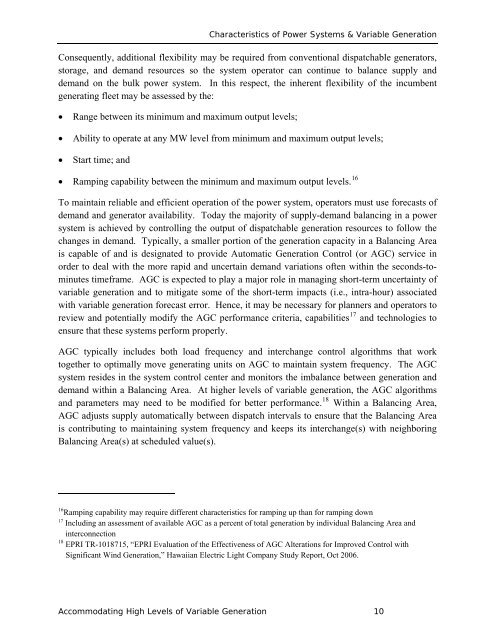Accommodating High Levels of Variable Generation - NERC
Accommodating High Levels of Variable Generation - NERC
Accommodating High Levels of Variable Generation - NERC
You also want an ePaper? Increase the reach of your titles
YUMPU automatically turns print PDFs into web optimized ePapers that Google loves.
Characteristics <strong>of</strong> Power Systems & <strong>Variable</strong> <strong>Generation</strong><br />
Consequently, additional flexibility may be required from conventional dispatchable generators,<br />
storage, and demand resources so the system operator can continue to balance supply and<br />
demand on the bulk power system. In this respect, the inherent flexibility <strong>of</strong> the incumbent<br />
generating fleet may be assessed by the:<br />
• Range between its minimum and maximum output levels;<br />
• Ability to operate at any MW level from minimum and maximum output levels;<br />
• Start time; and<br />
• Ramping capability between the minimum and maximum output levels. 16<br />
To maintain reliable and efficient operation <strong>of</strong> the power system, operators must use forecasts <strong>of</strong><br />
demand and generator availability. Today the majority <strong>of</strong> supply-demand balancing in a power<br />
system is achieved by controlling the output <strong>of</strong> dispatchable generation resources to follow the<br />
changes in demand. Typically, a smaller portion <strong>of</strong> the generation capacity in a Balancing Area<br />
is capable <strong>of</strong> and is designated to provide Automatic <strong>Generation</strong> Control (or AGC) service in<br />
order to deal with the more rapid and uncertain demand variations <strong>of</strong>ten within the seconds-tominutes<br />
timeframe. AGC is expected to play a major role in managing short-term uncertainty <strong>of</strong><br />
variable generation and to mitigate some <strong>of</strong> the short-term impacts (i.e., intra-hour) associated<br />
with variable generation forecast error. Hence, it may be necessary for planners and operators to<br />
review and potentially modify the AGC performance criteria, capabilities 17 and technologies to<br />
ensure that these systems perform properly.<br />
AGC typically includes both load frequency and interchange control algorithms that work<br />
together to optimally move generating units on AGC to maintain system frequency. The AGC<br />
system resides in the system control center and monitors the imbalance between generation and<br />
demand within a Balancing Area. At higher levels <strong>of</strong> variable generation, the AGC algorithms<br />
and parameters may need to be modified for better performance. 18 Within a Balancing Area,<br />
AGC adjusts supply automatically between dispatch intervals to ensure that the Balancing Area<br />
is contributing to maintaining system frequency and keeps its interchange(s) with neighboring<br />
Balancing Area(s) at scheduled value(s).<br />
16 Ramping capability may require different characteristics for ramping up than for ramping down<br />
17 Including an assessment <strong>of</strong> available AGC as a percent <strong>of</strong> total generation by individual Balancing Area and<br />
interconnection<br />
18 EPRI TR-1018715, “EPRI Evaluation <strong>of</strong> the Effectiveness <strong>of</strong> AGC Alterations for Improved Control with<br />
Significant Wind <strong>Generation</strong>,” Hawaiian Electric Light Company Study Report, Oct 2006.<br />
<strong>Accommodating</strong> <strong>High</strong> <strong>Levels</strong> <strong>of</strong> <strong>Variable</strong> <strong>Generation</strong> 10
















